Radula and colour variation in Okenia virginiae
December 21, 2004
From: Bill Rudman


In the recently posted Fact Sheet on Okenia virginiae there are photos of the holotype from South Africa and a specimen from Townsville, in Queensland, Australia, with only a few white lines on the dorsum. Here is another specimen from Townsville, with a much more reticulate pattern of white lines.
PHOTOS: Upper: Cape Pallarenda, Townsville, Queensland, Australia, 12mm long preserved, 22 May 1978, AM C112341. Photo: I. Loch. Lower: Scanning electron micrographs of radula. A, Section of whole radula. B, Section of left side of radula. Townsville, Queensland, Australia, 23 April 1975, AM C99445. Scale bar = 10 microns. Photo: G. Avern.
I have also included here some SEM photos of the radula. The shape of the teeth is quite characteristic of the Goniodorididae, with a large inner lateral tooth on each side, with small denticles along the cutting edge, and a small outer lateral tooth.
The radular formula is 26(+1) x 1.1.0.1.1 The innermost tooth has a broad base and a long elongate pointed cusp with many (40) narrow, relatively long, pointed denticles along the cutting edge. The denticles at the basal and terminal ends of the cusp are shorter than the rest. The much smaller outer teeth have a broad quadrangular base with a large recurved bluntly pointed cusp.
Bill Rudman
Rudman, W.B., 2004 (Dec 21) Radula and colour variation in Okenia virginiae . [Message in] Sea Slug Forum. Australian Museum, Sydney. Available from http://www.seaslugforum.net/find/12639Related messages
-
Pycnogonid predation on Okenia virginiae
From: Bill Rudman, May 18, 2005
